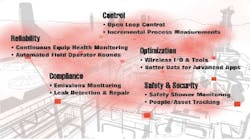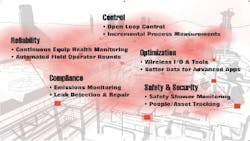Honeywell’s vision for wireless is all-encompassing. It includes field devices, closed-loop regulatory control, manufacturing operations, maintenance, asset management, regulatory compliance, and personnel safety. The company’s focus is on responding to a set of “key system requirements” that Honeywell has harvested from its sources, including extensive feedback from leaders in Honeywell’s large installed base of process manufacturers. To bring these solutions to market, Honeywell is developing several new products incorporating different wireless technologies, some well-established and others very new. Technology selection is a means to the end of satisfying these key customer requirements. Topping the requirements list are security, reliability, power management, and openness."
Next-Generation Field Devices
Honeywell is planning its second generation of battery-powered wireless field devices, which will operate with 10-years of battery life in most applications. These devices will perform with managed latencies, enabling their operation in regulatory control loops or very high-speed monitoring applications. These field devices will communicate directly with a new mains-powered wireless field infrastructure. This infrastructure can be as small as a single node for entry-level applications, but will form a mesh network of nodes as installations grow. Besides the new field devices, the infrastructure will support IEEE 802.11 WLAN applications and mobile clients, such as handheld computers and mobile HMIs. An updated base station will allow the new infrastructure to support Honeywell’s existing wireless transmitters. Several backhaul options will be available depending on existing infrastructure and national radio spectrum regulations.
Honeywell will promote openness for its field device technology through its existing PKS Advantage program. PKS Advantage member companies such as Dresser, Endress+Hauser, Flowserve, Krohne, and Yokogawa can add Honeywell’s second-generation sensor radio technology to its field devices with assistance from a set of radio specialists that Honeywell has enlisted for this purpose, including Aerocomm, Cambridge Consultants, Cirronet, LS Research, and Omnex Control Systems.
Location Services
Besides the new field devices, Honeywell highlighted its plans to use real-time location services (RTLS) to revolutionize a variety of process operating practices including process operations, safety and emergency responses, asset management, and unit turnarounds. Honeywell gave an impressive demonstration of this capability at HUG, with a productized solution and final technology choice pending.
The Honeywell RTLS demo featured a continuous RTLS data flow and real-time visualization of location information that is quite thought-provoking. These RTLS data streams represent a completely new class of real-time manufacturing information. This information can have value in all types of manufacturing operations (process, hybrid, or discrete) and in almost any business process. If this application can be brought into the manufacturing world economically, it will become a proverbial “next big thing.” ARC expects Honeywell will move its RTLS program forward as rapidly as possible.
Standardization via ISA
This wireless strategy has been a collaborative effort among multiple Honeywell business units, including its research labs. However, the key vehicle for driving this vision into standardization will be ISA’s SP100 organization. Next month, Honeywell propose this vision in more detail to the SP100.11 working group, and hopes to get much of its vision eventually voted into this document, which is just beginning its development and will not be finalized until 2008, at the earliest. The SP100 working group is focused on “Class 1 to Class 5” wireless applications, which encompass applications from closed-loop regulatory control to simple monitoring using a single architecture. Given Honeywell’s intention to extend wireless to control, while also addressing the general purpose wireless needs of an industrial facility, the SP100.11 working group has become the principal focus of Honeywell’s SP100 work. Thanks to Honeywell, the working group has recently acquired a professional facilitator with a solid track record in the IEEE 802 standardization process.
ARC Comments
ARC’s take on this briefing is that Honeywell sees wireless as the biggest and most important technology change in process automation since the microprocessor spawned the DCS in 1975. The company is not taking an incremental approach, but instead is rethinking and re-architecting its wireless networking product line with a view to extending its market leadership as the wireless revolution penetrates process manufacturing. Not merely a matter of wireless field devices, infrastructure, or even applications, Honeywell wants its wireless strategy to compel a very risk-averse customer base to change its work and business processes. Honeywell believes manufacturers are ready and willing to adopt such changes if they have confidence that the products they deploy truly meet this set of critical requirements.
The level of commitment shown by Honeywell to this initiative is quite impressive. Clearly the company is willing to push the envelope of available technology based on its understanding of customer requirements. Honeywell realizes that the SP100 process will involve compromise. There are a number of proposals pending before the working group. Honeywell has been a major contributor active in SP100 since its formation, and its wireless strategy shows that Honeywell has thought long and hard about how wireless should be used in future DCS products. (See Figure below)
THE WIRELESS CLOUDSome new aspects of Honeywell’s wireless roadmap, in particular the sensor radio technologies that are as yet not standardized, will be received as controversial proposals unless Honeywell includes a plan for incorporating them into a future standard. IEEE 802 is the best candidate to accomplish this since it is the only organization focused on coexistence among the high-volume wireless technologies that now share the unlicensed ISM bands, most of which are already defined by existing 802 standards (such as Wi-Fi, Bluetooth, and ZigBee). Despite the inevitable controversy, it seems to ARC that no process automation company today has more ambitious or more concrete plans for a wireless future than Honeywell.





